U.S. Department of Transportation
Federal Highway Administration
1200 New Jersey Avenue, SE
Washington, DC 20590
202-366-4000
Federal Highway Administration Research and Technology
Coordinating, Developing, and Delivering Highway Transportation Innovations
|
Research & Technology Transporter This newsletter is an archived publication and may contain dated technical, contact, and link information. |
|
| Publication Number: N/A Date: June 1998 |
Publication Date: June 1998
|
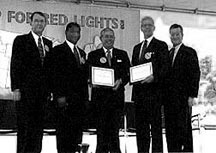
On April 30, Transportation Secretary Rodney E. Slater announced a new partnership with the Chrysler Corporation and the American Trauma Society (ATS) to combat red light running which is a major reason why more than 8,000 people are killed annually in crashes at intersections. Secretary Slater was joined by Chrysler Corporation Chief Executive Officer Robert J. Eaton, American Trauma Society Executive Director Harry Teter, FHWA Administrator Kenneth Wykle, and National Highway Traffic Safety Administrator (NHTSA) Ricardo Martinez in making the announcement at a press conference on the grounds of the Washington Monument in Washington, D.C.
Secretary Rodney E. Slater applauded the success of FHWA's first red light running (RLR) campaign and announced the new partnership which will continue the campaign into next year. . ATS selected FHWA's red light running prevention program as its featured campaign for 1998, and the Chrysler Corporation selected it as one of their top four safety education campaigns they'll support over the next year.
"Safety is President Clinton's highest transportation priority, and now we have two additional partners to champion safety," Secretary Slater said. "Our partnership in educating drivers about the hazards of running red lights will prevent injuries and save lives." The partnership marks the beginning of the second phase of FHWA's red light running campaign which is part of the Department's efforts to decrease roadway-related injuries by 20 percent over the next 10 years and increasing the number of "safe communities nationwide."
FHWA provides participating sites a red light running Strategic Planning Guide, camera-ready print materials, and broadcast quality Public Service Announcements. The ATS members will dedicate trauma center staff and resources to implement local RLR campaigns. The Chrysler Corporation will dedicate the services of their public relations firm to assist sites with local campaign implementationas along with providing RLR materials. As a result of this three-way partnership, almost 200 trauma centers throughout the country will start local red light running safety outreach campaigns.
- Mila Plosky
Examples of successful technology transfer abound in the transportation community, and FHWA is working with its partners to make them possible. The Cypress Freeway Replacement Project in Oakland, CA, highlighted community action and used new materials and methods. The Red Light Running campaign launches a new safety program into the media spotlight. Partnerships with States and industry highlight SuperpaveTM initiatives, improving the performance of asphalt pavement with an innovative array of equipment. These activities have a common theme - a focus on the customer. This philosophy is at the core of FHWA's marketing approach for the highway program.
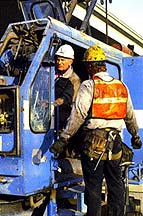
FHWA embraced the marketing concept in 1990 as a dynamic way to keep pace with new technology - a strategy through which innovative highway products could be more effectively developed and moved into use. Marketing streamlines the technology implementation process, to help target key audiences and outreach activities for these products. Simply put, marketing is knowing what the customer wants or needs and providing the right mechanism and timing for delivery of an effective product. FHWA has a whole range of marketable products, including technology programs, innovative materials, equipment, procedures, computer hardware, and software.
Successful marketing is a team effort that taps different skills and backgrounds. FHWA's field offices assess and communicate user needs and serve as liaison for technology transfer. Subject experts work with partners on technical panels and projects to develop useful product features which help nurture a receptive audience. Technology applications personnel provide outreach resources and communications tools. Federal and State agencies, local governments, industry, the academic community, and international organizations are involved throughout to help define the need and contribute to the research, development, deployment, and implementation.
Marketing is a dynamic process in support of technology transfer, responsive to product evolution, events, and user need. The tools of marketing help develop targeted implementation strategies that can best communicate product features, advantages, and benefits, and provide feedback mechanisms to evaluate success of technology transferred.
- Martha M. Soneira, (202) 366-8029, martha.soneira@fhwa.dot.gov
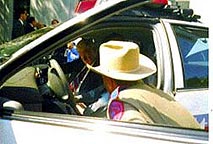
The National Performance Review recently awarded $1 million for information technology innovation to the FHWA and the National Institute of Justice (NIJ). The funding was awarded for the proposal by FHWA and NIJ on, "Continued Development and Field Testing of the Advanced Law Enforcement and Response Technology (ALERT)".
The ALERT Project highlights the benefits of integrating technology in the public safety community. ALERT provides the public safety official responding to an incident with a standard, integrated mobile communications and control system. On board peripherals such as video cameras, laptop computers, radios, and other emergency systems operate within a seamless control environment. Together they facilitates data collection and communications which provides a greater margin of safety for the operator of the ALERT vehicle.
- David Smith, (202) 366-6614, david.smith@fhwa.dot.gov
The Long Term Pavement Performance (LTPP) program launched the next stage of its data-resolution effort in late May with the first in a series of State and Province "data-resolution meetings." The purpose of these meetings, which will be conducted over the next several months, is to resolve issues relating to missing or questionable data from LTPP test sections.
The Data Resolution effort was initiated last year. The first stage involved modernizing LTPP's computer hardware and software, and reorganizing its data-processing procedures. The second stage involved processing all of the data LTPP collected to date and compiling results into data status reports for each State and Province.
The next stage of the effort involves meeting with the States and Provinces to review the data status reports, discuss both the data's completeness and quality issues related to specific test sections, identify which data issues can be resolved, and develop a data resolution action plan. Resolving issues related to missing and questionable data maximizes LTPP's ability to deliver the high quality data required to develop the tools that engineers and managers need to make decisions that will lead to better performing, more cost-effective pavements. More information can be found at: http://www.tfhrc.gov/pavements/ltpp/ltpphome.htm
- Monte Symons, (202) 493-3144, monte.symons@fhwa.dot.gov
For the first time ever, concrete was tested under TFHRC's Accelerated Loading Facility (ALF) on May 11. After the official Cooperative Research and Development Agreement (CRADA) signing earlier in the day, FHWA Deputy Administrator Gloria Jeff spoke at an open house celebration marking the beginning of this landmark test of an ultra-thin whitetopping (UTW). The CRADA between FHWA and the American Concrete Pavement Association (ACPA) calls for the design, construction, evaluation, and cost sharing of this innovation in concrete pavement technology.
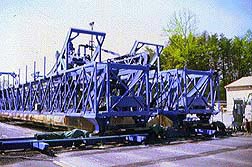
The ALF wheel loads used for this study will be 4536 kg on dual 11R22.5 radial ply truck tires, which will travel at 16 km/h in a single wheel path. ALF applies an average of 50,000 loads per week, testing 24 hours a day. Initial tests are being done on eight, 14.5-m lanes. The UTW overlays are 6.4 cm and 8.9 cm, with and without polypropylene fibers, and have 1-m, 1.2-m, and 2-m joint spacings. The previously tested asphalt concrete pavements were milled 6.4 cm and 8.9 cm. The original test pavements were 20.3 cm of asphalt concrete (AC) over 45.7 cm of crushed stone base.
A series of standard concrete quality-control tests, including temperature, slump, unit weight and air content were conducted by FHWA during construction. In addition, 72 concrete cylinders and 32 beams were prepared to be tested for compressive strength, modulus of elasticity, and flexural strength after 28 days and at the age when the ALF load tests begin on each lane. Another series of core tests will measure the UTW-to-asphalt bond strengths using a procedure developed by Iowa DOT. The k-value of the subgrade and the modulus of the AC, both inputs to the ACPA overlay design procedure, will be computed from Falling Weight Deflectometer and laboratory tests.
The Virginia Ready Mix Concrete Association, Northern Advisory Council built the UTW mixes and pavements. ACPA will evaluate the UTW overlay design procedure. FHWA will test the material properties for all pavement layers and will provide these inputs to the ACPA for evaluation of the design method.
- James Sherwood, (202) 493-3150, jim.sherwood@fhwa.dot.gov
Bridge paint inspection is far from glamorous work, but this task has become much easier now with FHWA's new step-by-step inspection manual. The new manual provides information necessary to guide and instruct inspectors in the performance requirements of the job. It is the first in a series of five and was developed from recent FHWA-sponsored research results and sources, such as the National Highway Institute (NHI) Training Course for Bridge Paint Inspectors and the ASTM 3276-86 Standard Guide for Paint Inspectors. The manual was put together and published by the FHWA bridge technology team.
The manual describes all required pre-painting operations and the do's and don'ts in the inspection of enclosures, surface preparation, and material handling. It contains valuable information about health and safety issues. There are several checklists that correspond with individual inspection tasks. These checklists are intended to serve as reminders of the major items to be checked at each stage of the inspection. The manual contains pictures and descriptions of the equipment used during field inspections. It is currently available in hard copy and is now on TFHRC's web page.
- Bob Kogler.

Jim Cooper, Chief of the Structures Division, was one of only a dozen foreign officials invited to attend the opening of the world's longest suspension bridge, the Akashi Kaikyo Bridge in Japan. He presented a congratulatory letter from FHWA Administrator Kenneth Wykle to the Executive Director of the Honshu-Shikoku Bridge Authority. An evening lighting ceremony on April 4 at the bridge, spanning the Akashi Straits, preceded the ribbon-cutting ceremony on the morning of April 5. Following a parade of the 1,500 invited guests across the bridge, the Crown Prince and Princess officiated the formal ceremony. Cooper spent the day at the bridge site, discussing long-span bridge technologies.
The Akashi Kaikyo Bridge, also known in Japan as the Pearl Bridge, has a record main span of 1991 meters. By comparison, the bridge is 366 meters (almost 1/4 mile) longer than the previous record holder, the StoreBaelt (East Bridge) in Denmark, which was also opened in 1998. The Akashi Kaikyo Bridge is also 580 meters longer than the Humber Bridge in England, constructed in 1981; 692 meters longer than the longest suspension bridge in the United States, the Verrazano-Narrows Bridge in New York, built in 1964; and 710 meters longer than the Golden Gate Bridge in San Francisco, constructed in 1937.
Bridge costs, estimated at 500 billion Japanese yen, translates to about $3.6 billion. Cooper followed the design and construction of the bridge since 1985. More information can be found at: http://www.tfhrc.gov/structur/structur.htm
- Jim Cooper
Though traffic signal control equipment has evolved from electro-mechanical/vacuum tube technology to the current large scale integration (LSI) technology, the control concepts have virtually remained unchanged since the 1920's. FHWA's Intelligent Transportation Systems (ITS) program is trying to change this.
In 1995, FHWA established a steering committee composed of public and private sector individuals to develop specifications for the advanced transportation controller and cabinet. They have developed specifications for procurement of next generation traffic signal controllers. Presently, thousand of these controllers are on order or delivered for use in ITS applications. The work to develop an ITS cabinet is continuing with a draft document to be circulated in June 1998.
Traffic signal control equipment was designed to operate traffic signals that limited the flexibility of traffic control strategies. The hardware is also designed to react to traffic flows, and under severe congestion this strategy does not produce appropriate results. With the advancement of neural networks and artificial intelligence, it is now possible to develop software that is forward-looking and can support multiple tasks and functions. The steering group's specifications take into account these concepts and fully use new technology.
The key aspect of both the controller and the cabinet is that they support up to 19 ITS user services, ranging from traffic control to electronic toll collection. Also, the new cabinet design uses extensive communication technology rather than the previous hardwire point-to-point connections. The cabinet document will be finalized and released to the users in 1998. More information can be found at:
- Raj S. Ghaman, (202) 493-3270, raj.ghaman@fhwa.dot.gov
Traffic management centers (TMCs) in the intelligent transportation systems era will feature hundreds of remote closed-circuit television (CCTV) cameras for monitoring the roadway system as well as identifying and verifying incidents. Operators will have to quickly select appropriate cameras and control their pointing angles, zoom ratio, and focus.

A series of three experiments was conducted to evaluate existing and proposed approaches for selecting and controlling arrays of remote cameras. Four basic interface concepts were evaluated: joystick, keyboard, mouse, and touchscreen. In addition, interfaces in which cameras moved between preprogrammed pointing angles were compared to interfaces in which the operators had full manual control of the cameras.
Experimental subjects in the TMC Human Factors Research Simulator were trained to use a suite of 24 simulated cameras to search for incidents and to report the locations of incidents they found. The simulator provided a realistic simulation of a CCTV system on the Atlanta freeway network.
Operators using a touchscreen interface made significantly more errors when selecting cameras than did those using the other interfaces. When manipulating cameras, operators using keyboard and mouse were able to manipulate the cameras more effectively than those using joystick or touchscreen. Cameras with preset pointing angles were found to be significantly more efficient than those with fully manual controllers. Operators using the preset cameras, however, needed a mechanism to fine tune the pointing angles. Thus, a hybrid approach in which the camera automatically moves to an approximate position and the operator manually centers the camera on the point of interest was strongly preferred. More information can be found at: http://www.tfhrc.gov/its/itshome.htm
- Nazy Sobhi
The participation at the first regional conference in Latin America on Intelligent Transportation Systems exceeded initial expectations by nearly two-fold and signalled the clear demand for high technology solutions for transportation issues. Urban congestion, high road fatality rates, and infrastructure privatization are among the challenges facing the region. The conference provided a forum for interaction between Latin American and international transportation professionals.
Sponsored by ITS America and the International Road Federation, the conference was held in Buenos Aires, Argentina, from March 24-27, 1998, and was attended by 450 professionals from 17 countries. The local organizing committee was chaired by Mr. Rafael Balcells, President of the Argentine Road Association.
The Federal Highway Administration was a sponsor, with representation by the Intelligent Transportation Systems Joint Program Office (ITS/JPO), the National Highway Institute (NHI), and the Office of International Programs. Dr. Christine M. Johnson, Director of ITS/JPO, was the keynote speaker. She captivated the audience with her talk on the approach to saving lives and time and to improving the quality of life by implementing ITS across the United States within a decade. She addressed the benefits and potential of ITS and the importance of common standards.
Liana Montero of NHI coordinated a pre-conference seminar entitled AViable Transportation Using ITS: A Seminar for Public Officials and Private Sector Managers.@ Greg Speier, Executive Director of the Pan American Institute of Highways (PIH), moderated the full-day session. Panelists in the seminar included Anson Nordby of the City of Los Angeles and Philip Tarnoff of the Transportation Studies Center, University of Maryland. There were 10 seminars C all held in English and Spanish C covering technical and policy issues during the conference. The conference also included 31 exhibitors of goods and services from around the world. The United States was well-represented with 14 exhibitors. As a result of this conference, the PIH center in Buenos Aires is arranging 4 post-conference seminars throughout Argentina to reach a wider audience.
- C Marianna A. Rizzo, 202-366-9631. international@fhwa.dot.gov
FHWA's Office of Environment and Planning released its first strategic plan which identifies the research priorities for the Environmental Research Program (ERP) for the next six years, 1998-2003.
The Environmental Research Strategic Plan has three research focus areas: natural environment, human environment, and integrated decision-making. The strategic plan includes strategies for implementing stated initiatives through coordination and partnerships, outreach efforts, and information dissemination. Another critical element of the plan is a commitment to encourage and recognize exemplary environmental research efforts of partners and stakeholders. Finally, the Strategic Plan allows for the evaluation of Environmental Research Program elements and products to ensure that the program remains responsive to changing customer needs and conditions and that it is effective in achieving identified goals.
Copies of the Strategic Plan for Environmental Research, 1998-2003 may be requested by calling the Office of Environment and Planning, Environmental Analysis Division, (202) 366-2069. The web site address is: www.fhwa.dot.gov/environment.
- Connie Hill, connie.hill@fhwa.dot.gov

Using the Small Business Innovation Research Program, the Environmental Analysis Division is developing an inexpensive sampling device that could be used with sheet flow to collect discrete or composite highway water samples during a storm. The monitoring device should decrease the costs associated with sampling and should increase the volume of monitoring data and information for compliance with the National Pollution Discharge Elimination System and for environmental evaluations. It is being designed to be easy to install and implement.
Phase I of the research was completed last year. The contractor, GKY & Associates, developed a prototype sheet-flow sampler that is small, simple to operate, productive, and is cost-effective to operate and maintain in a highway environment.
Phase II of the research started last fall and initiated the development and testing of numerous field sites with the cooperation of various State DOTs. The study deals with the manufacture of the device, along with development of channels of distribution, and manuals of installation and operation. Upon completion of Phase II, the samplers will be manufactured and sold to State highway administrations and other local agencies for their monitoring needs. More information can be found at: https://www.fhwa.dot.gov/environment
- Patricia Cazenas, (202) 366-4085, patricia.cazenas@fhwa.dot.gov
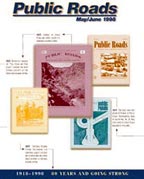
Public Roads was first published in May 1918. So, that makes the magazine 80 years old. But this is not an old, stodgy magazine.
In several ways, Public Roads is still very young. After the passage of the Intermodal Surface Transportation Efficiency Act of 1991 (ISTEA), the content and audience of Public Roads has broadened. It has dropped its subtitle-A Journal of Highway Research and Development-and unveiled a new design, as well as an expanded scope and distribution that reflected its enlarged mission to represent the entire FHWA. Today, along with its base of articles on research and technology, each issue features articles related to the policies and programs of FHWA.
In a formal readership survey conducted in 1995, 90.5 percent of the 700 respondents said Public Roads meets their needs well or very well. Almost 88 percent said recent design changes have made the magazine more interesting, and 83 percent said they now read the magazine more as a result of these changes. Almost 88 percent said the expanded scope of the magazine made it more interesting, and more than 84 percent now read more of the magazine.
As a result of the survey we have increased our publication frequency from quarterly to bimonthly, starting in July/August 1997. For the 14.6 percent who wanted the magazine to cover more topics and for the readers who wanted more information about research and technology, we now provide 50 percent more information over the course of a year.
At Public Roads, we are excited about being a part of communicating the FHWA contributions to building a better, more technologically advanced society. For 80 years, the magazine has been the chronicle of advancements in surface transportation, and we are proud to continue in that tradition.
- Bob Bryant